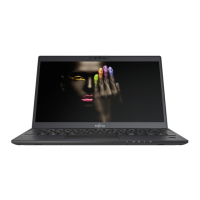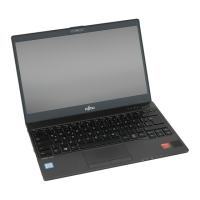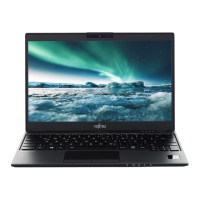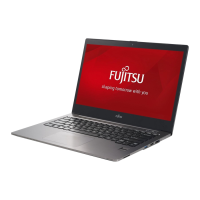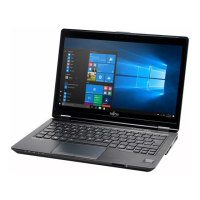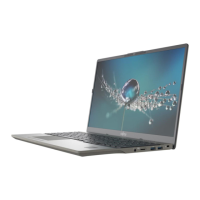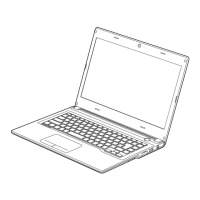Do you have a question about the Fujitsu LifeBook U9312 and is the answer not in the manual?
Provides information on Windows drivers and other software.
Explains warning and information symbols used for safety and usage guidance.
Explains text, font, and key notations used in the manual for clarity.
Identifies indicators and ports on the front of the notebook.
Details security lock, USB, HDMI, and battery status indicator on the left.
Details SIM card slot, memory card slot, and LAN port on the right.
Identifies speakers and the battery off button on the bottom of the notebook.
Covers essential safety information and warnings for notebook operation.
Provides instructions on how to safely open the notebook's LCD screen.
Safety precautions for devices with wireless LAN, Bluetooth, and LTE.
Tips for reducing power consumption and extending battery life.
Advice for traveling with the notebook, including international travel.
Guidelines for safely transporting the notebook to prevent damage.
Instructions for cleaning the notebook's exterior and screen safely.
Steps to take if liquid is accidentally spilled on the notebook.
Steps for unpacking and inspecting the notebook for shipping damage.
Guidance on choosing a suitable and safe place to set up the notebook.
Instructions for connecting the power adapter to the notebook and a power outlet.
Procedures for the initial startup and software installation of the notebook.
Explains the meaning of various status lights on the notebook.
Detailed explanation of power, battery, F Lock, Num Lock, Caps Lock, and Scroll Lock indicators.
Step-by-step guide on how to switch the notebook on and off.
Information on notebook keyboard features, wear, and overlaid functions.
Explains the function of keys like Backspace, Tab, Enter, Caps Lock, Shift, Fn, Windows, and Menu.
How to use the virtual numeric keypad and its default settings.
Details the functions of F1 through F10 keys and their combinations.
Explains Prt Scrn, Num Lock, and key combinations like Alt+Tab, Ctrl+Alt+Del.
How to manage F-Lock, keyboard backlight, and country settings.
How to use the touchpad and its buttons for cursor control and selection.
Guides on moving the pointer, selecting items, and executing commands with the touchpad.
Instructions on how to drag and move items using the touchpad.
Explains how to use finger gestures for navigation and interaction on the touchscreen.
Information on LCD screen resolution, pixel quality, and background lighting.
Details about the webcam, its status indicator, shutter, and picture quality.
Information on increasing battery life, charge modes, and care.
Guidelines for charging the battery under different ambient temperatures and monitoring its level.
Procedures for safely switching the notebook's battery off and then on again.
How to use power-saving modes and features in Windows for efficiency.
How to adjust system performance settings in Windows for power or speed.
Options for adjusting fan speed (Silent/Normal) via BIOS or utility.
Lists supported formats and provides instructions for card insertion/removal.
Information on the placement of speakers/microphones and their functionality.
Instructions for inserting a Nano-SIM card into the notebook.
Instructions for safely removing a SIM card from the notebook.
Information on wireless LAN, Bluetooth, LTE, and 5G capabilities.
How to switch wireless components on/off and set up WLAN access.
Information on connecting to LTE or 5G networks using accessories or built-in modules.
Instructions for connecting the notebook to a local area network via Ethernet.
Introduction to the optional port replicator for connecting peripherals.
Details the various ports available on the Thunderbolt port replicator.
Explains the power and charge level indicators on the port replicator.
Guidance on selecting a suitable location for the port replicator.
Instructions for connecting the power adapter to the port replicator.
Steps for connecting the notebook to the port replicator using a Thunderbolt cable.
How to switch on the notebook using the port replicator's power button.
Safe procedure for disconnecting the notebook from the port replicator.
Introduces the notebook's security features for protecting against unauthorized access.
Steps for setting up and using the fingerprint sensor for authentication.
Information on palm vein sensor setup and using the security lock cable.
Guidance on setting up supervisor and user passwords in the BIOS Setup Utility.
Details on protecting BIOS Setup access with supervisor and user passwords.
How to assign, change, and remove supervisor and user passwords in BIOS.
How to set up password protection for the operating system boot process.
How to set up password protection for the hard disk drive.
Information on using the optional Smart Card reader for security.
Instructions for inserting a Smart Card into the reader.
General safety notes before connecting or disconnecting external devices.
How to connect external audio/video devices using the HDMI port.
Connecting an external monitor using the port replicator's display ports.
How to connect various USB devices and information on USB standards.
Details on the USB Type-C port's charging and display capabilities.
How to use the USB port for charging devices even when the notebook is off.
Procedure for safely disconnecting USB devices to prevent data loss.
How to connect headsets, headphones, or microphones to the notebook.
Warning about unauthorized repairs and potential damage or warranty invalidation.
Explains the purpose of BIOS Setup and its main menus.
Step-by-step instructions to enter the BIOS Setup Utility.
How to navigate and change settings within the BIOS Setup Utility.
Options for exiting BIOS Setup, including saving or discarding changes.
How to securely delete data from hard disks/SSD memory modules using the BIOS utility.
Details the different deletion algorithms and procedures for the Erase Disk function.
Advice on how to approach and resolve common faults and errors.
How to contact support and what information to provide for assistance.
Procedures for resetting the battery and restoring the system from recovery media.
Troubleshooting for incorrect date/time and keyboard numeral input problems.
Solutions for blank screen, poor readability, and glare issues on the LCD.
Troubleshooting for blank or unstable images on external monitors.
Solutions for problems like the notebook not starting or stopping unexpectedly.
Troubleshooting steps if the printer is not printing correctly.
How to fix wireless network issues and Smart Card reader/PIN problems.
Explains common BIOS Setup error messages and their resolutions.
Further explanations of BIOS error messages and recommended actions.
Lists ambient conditions, dimensions, weight, and main memory specifications.
Details on the notebook's rechargeable battery, including voltage and capacity.
Technical specifications for the notebook's and port replicator's mains adapters.
Information on disposal, recycling, TCO, and other certification markings.
Provides information on Windows drivers and other software.
Explains warning and information symbols used for safety and usage guidance.
Explains text, font, and key notations used in the manual for clarity.
Identifies indicators and ports on the front of the notebook.
Details security lock, USB, HDMI, and battery status indicator on the left.
Details SIM card slot, memory card slot, and LAN port on the right.
Identifies speakers and the battery off button on the bottom of the notebook.
Covers essential safety information and warnings for notebook operation.
Provides instructions on how to safely open the notebook's LCD screen.
Safety precautions for devices with wireless LAN, Bluetooth, and LTE.
Tips for reducing power consumption and extending battery life.
Advice for traveling with the notebook, including international travel.
Guidelines for safely transporting the notebook to prevent damage.
Instructions for cleaning the notebook's exterior and screen safely.
Steps to take if liquid is accidentally spilled on the notebook.
Steps for unpacking and inspecting the notebook for shipping damage.
Guidance on choosing a suitable and safe place to set up the notebook.
Instructions for connecting the power adapter to the notebook and a power outlet.
Procedures for the initial startup and software installation of the notebook.
Explains the meaning of various status lights on the notebook.
Detailed explanation of power, battery, F Lock, Num Lock, Caps Lock, and Scroll Lock indicators.
Step-by-step guide on how to switch the notebook on and off.
Information on notebook keyboard features, wear, and overlaid functions.
Explains the function of keys like Backspace, Tab, Enter, Caps Lock, Shift, Fn, Windows, and Menu.
How to use the virtual numeric keypad and its default settings.
Details the functions of F1 through F10 keys and their combinations.
Explains Prt Scrn, Num Lock, and key combinations like Alt+Tab, Ctrl+Alt+Del.
How to manage F-Lock, keyboard backlight, and country settings.
How to use the touchpad and its buttons for cursor control and selection.
Guides on moving the pointer, selecting items, and executing commands with the touchpad.
Instructions on how to drag and move items using the touchpad.
Explains how to use finger gestures for navigation and interaction on the touchscreen.
Information on LCD screen resolution, pixel quality, and background lighting.
Details about the webcam, its status indicator, shutter, and picture quality.
Information on increasing battery life, charge modes, and care.
Guidelines for charging the battery under different ambient temperatures and monitoring its level.
Procedures for safely switching the notebook's battery off and then on again.
How to use power-saving modes and features in Windows for efficiency.
How to adjust system performance settings in Windows for power or speed.
Options for adjusting fan speed (Silent/Normal) via BIOS or utility.
Lists supported formats and provides instructions for card insertion/removal.
Information on the placement of speakers/microphones and their functionality.
Instructions for inserting a Nano-SIM card into the notebook.
Instructions for safely removing a SIM card from the notebook.
Information on wireless LAN, Bluetooth, LTE, and 5G capabilities.
How to switch wireless components on/off and set up WLAN access.
Information on connecting to LTE or 5G networks using accessories or built-in modules.
Instructions for connecting the notebook to a local area network via Ethernet.
Introduction to the optional port replicator for connecting peripherals.
Details the various ports available on the Thunderbolt port replicator.
Explains the power and charge level indicators on the port replicator.
Guidance on selecting a suitable location for the port replicator.
Instructions for connecting the power adapter to the port replicator.
Steps for connecting the notebook to the port replicator using a Thunderbolt cable.
How to switch on the notebook using the port replicator's power button.
Safe procedure for disconnecting the notebook from the port replicator.
Introduces the notebook's security features for protecting against unauthorized access.
Steps for setting up and using the fingerprint sensor for authentication.
Information on palm vein sensor setup and using the security lock cable.
Guidance on setting up supervisor and user passwords in the BIOS Setup Utility.
Details on protecting BIOS Setup access with supervisor and user passwords.
How to assign, change, and remove supervisor and user passwords in BIOS.
How to set up password protection for the operating system boot process.
How to set up password protection for the hard disk drive.
Information on using the optional Smart Card reader for security.
Instructions for inserting a Smart Card into the reader.
General safety notes before connecting or disconnecting external devices.
How to connect external audio/video devices using the HDMI port.
Connecting an external monitor using the port replicator's display ports.
How to connect various USB devices and information on USB standards.
Details on the USB Type-C port's charging and display capabilities.
How to use the USB port for charging devices even when the notebook is off.
Procedure for safely disconnecting USB devices to prevent data loss.
How to connect headsets, headphones, or microphones to the notebook.
Warning about unauthorized repairs and potential damage or warranty invalidation.
Explains the purpose of BIOS Setup and its main menus.
Step-by-step instructions to enter the BIOS Setup Utility.
How to navigate and change settings within the BIOS Setup Utility.
Options for exiting BIOS Setup, including saving or discarding changes.
How to securely delete data from hard disks/SSD memory modules using the BIOS utility.
Details the different deletion algorithms and procedures for the Erase Disk function.
Advice on how to approach and resolve common faults and errors.
How to contact support and what information to provide for assistance.
Procedures for resetting the battery and restoring the system from recovery media.
Troubleshooting for incorrect date/time and keyboard numeral input problems.
Solutions for blank screen, poor readability, and glare issues on the LCD.
Troubleshooting for blank or unstable images on external monitors.
Solutions for problems like the notebook not starting or stopping unexpectedly.
Troubleshooting steps if the printer is not printing correctly.
How to fix wireless network issues and Smart Card reader/PIN problems.
Explains common BIOS Setup error messages and their resolutions.
Further explanations of BIOS error messages and recommended actions.
Lists ambient conditions, dimensions, weight, and main memory specifications.
Details on the notebook's rechargeable battery, including voltage and capacity.
Technical specifications for the notebook's and port replicator's mains adapters.
Information on disposal, recycling, TCO, and other certification markings.
| Operating System | Windows 10 Pro |
|---|---|
| Battery Life | Up to 15 hours |
| Display | 13.3-inch, 1920 x 1080 pixels |
| RAM | 8 GB or 16 GB |
| Storage | 256 GB, 512 GB |
| Graphics | Intel Iris Xe Graphics (integrated) |
| Ports | HDMI, headphone/microphone combo |
| Wireless | Wi-Fi 6, Bluetooth 5.0 |
